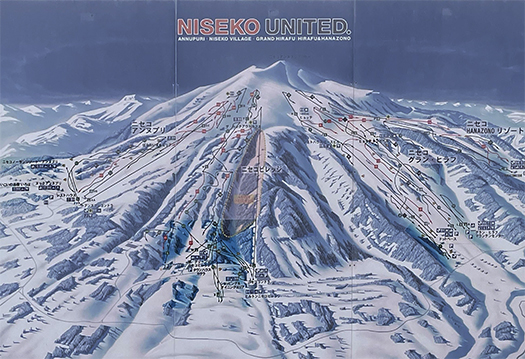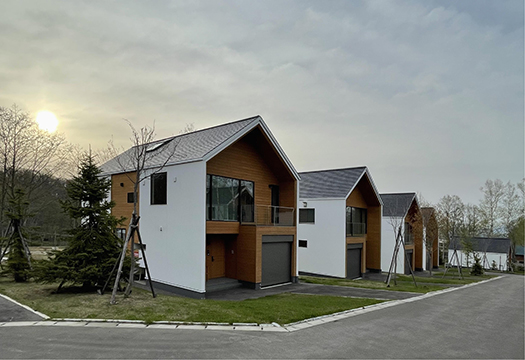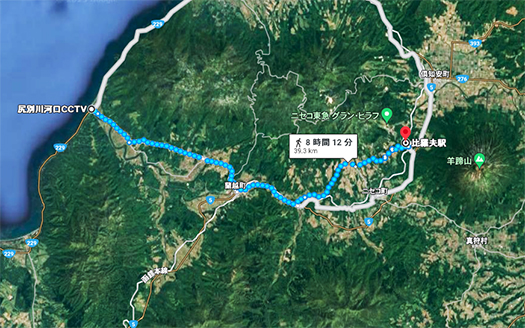

連休中に訪れていたニセコ地域で縄文期遺跡など思わぬ歴史事実との遭遇。歴史好きの本性は、最近すっかり本州地区行脚に費やされていましたが、今回で北海道地元にスポットが当たってしまった。北海道人としては、後世のひとたちにこういった歴史情報を解明しておく責任の一端はあるかもしれない。もちろん専門研究者の情報に基づいて、広く興味を拡散して世論を醸成するという意味合い。
この羊蹄山周辺地域はいまや世界的な雪質レベルでのリゾート開発が盛ん。世界的なスキーリゾートとして欧米からの来訪者で大いに賑わっている。図のように「NISEKO UNITED」ということでシルキースノーゾーンが広がっている。日本人ではスキー人口はそれほど伸びているとは聞かないけれど、シーズンになると英語などの方が当地では優勢になるそうです。わたし自身はスキー学校授業程度ほぼ興味がない。そういうことなので来るのはもっぱら夏場ということになるけれど・・・。
どうもこの地にはそういう「外からの注目」が集まりやすいのかも知れない。今回歴史好きとしてふとした気付きから日本・ヤマト王権が北方国防対策として、この地域に軍団遠征を200艘もの大船団で行った事実は大変なインパクト。659年当時はオホーツク人という北方からの「外圧」への対応だったのだろうが、ある意味では土地が持つ「気」のようなものが外部から人を呼び寄せるのかも知れない(笑)。
写真のように北海道の建築関係者にとって当地のリゾート開発建築の最初期は素性の定かでないオーストラリアの不動産業者による進出で、信用状況でもやや不安を持たざるを得ない取引だったという。サンモリッツなどの欧米のハイエンドリゾート需要、そうした活発な投資活動は北海道全体にとって有意義。現在では多くの貸別荘群がゲレンデ周辺の好適地で新築されてきている。ヒルトンなどの欧米資本の進出もある。

さて歴史好きの阿倍比羅夫遠征での「後方羊蹄」についての調査活動。その当時の朝鮮・白村江海戦での日本側遠征船団と人員規模について、好きな歴史作家・安部龍太郎氏の論考では1艘あたり30人の兵員輸送だったとされるので、200艘船団では5,000-6,000人規模の大遠征軍団。
逆に言えばこうした大船団が編成されたので北から西に方向転換して白村江海戦に突入してしまった、とも言えるのだろうか。この軍勢が河口に上陸し、兵糧などの運搬に適した尻別川が通っている「比羅夫」という地名が残る羊蹄山麓まで、GoogleMapでの陸上歩行時間距離では8時間ほどとなっている。
この距離感であれば1−2日の行程で武装しての進軍も可能だったことだろう。
羊蹄山麓地域まで阿倍比羅夫を護送するのには50-60人程度の軍勢で十分か。環境要因を見てみればたしかに軍事移動は十分可能だっただろう。政庁の設置も可能だと思えるが、さて。
Enlish version⬇
1364 Years Ago and Today: Encounters with Yamato Royalty and the World in Yotei Foothills
Is this the local environment that attracts the most “outside attention” in Hokkaido now and in the past? World-class ski resorts and the Abenohirou expedition. …
While visiting the Niseko area during the holidays, I came across some unexpected historical facts, including Jomon-period ruins. My love of history has recently been completely consumed by my travels in the Honshu area, but this time I found myself in the Hokkaido area. As a Hokkaido native, I may have a part of responsibility to clarify this kind of historical information for future generations. Of course, this is based on information from professional researchers, but it is also meant to spread interest and foster public opinion.
The area surrounding Mt. Yotei is now being actively developed as a resort with world-class snow quality levels. As a world-class ski resort, it is very crowded with visitors from Europe and the United States. As shown in the figure, a silky snow zone called “NISEKO UNITED” is spreading. Although I don’t hear that the ski population is growing that much among Japanese, I hear that English and other languages are predominant in this area during the season. I myself am not interested in ski school classes. So I come here only in the summer.
I guess it is easy to attract such “attention from outside” to this place. As a history buff, I suddenly realized that the fact that the Yamato Kingdom of Japan conducted a military expedition with a fleet of 200 ships to this area as a measure to defend the northern part of the country had a great impact on me. In a sense, the “spirit” of the land may have attracted people from the outside (laughs).
As you can see in the photo, for architects in Hokkaido, the initial resort development construction in the area was done by an Australian real estate developer of unknown background, and they had to be a little apprehensive about the credit situation. The demand for high-end resorts in Europe and the U.S., such as St. Moritz, and such active investment activities are meaningful for Hokkaido as a whole. Many new rental villa complexes are now being built in prime locations near the slopes. There is also the entry of European and U.S. capital such as Hilton.
Now, research activities about “Rear Yotei” in the Abenohirao expedition of history buffs. According to my favorite history writer, Ryutaro Abe, the Japanese expeditionary fleet and its personnel size at that time at the Battle of Paekchon River in Joseon was said to have transported 30 soldiers per ship, so a fleet of 200 ships was a large expeditionary force of 5,000 to 6,000 soldiers.
Conversely, it could be said that such a large fleet was organized, so it changed direction from north to west and plunged into the Battle of Hakuchon River. According to Google Map, it takes about 8 hours to reach the foot of Mt. Yotei, where the Shiribetsu River, which is suitable for transporting food and supplies, runs through.
This distance would have made it possible to march armed to the teeth in one or two days.
A force of about 50-60 men would have been sufficient to escort Abephirao to the foot of Mt. Looking at the environmental factors, it would certainly have been possible to move the military. It would also be possible to set up a government office.
Posted on 5月 8th, 2023 by 三木 奎吾
Filed under: 日本社会・文化研究







コメントを投稿
「※誹謗中傷や、悪意のある書き込み、営利目的などのコメントを防ぐために、投稿された全てのコメントは一時的に保留されますのでご了承ください。」
You must be logged in to post a comment.